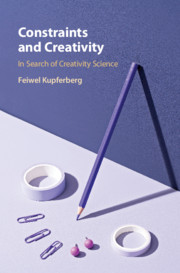Book contents
- Constraints and Creativity
- Constraints and Creativity
- Copyright page
- Contents
- Prolegomenon
- Preface
- Introduction
- Part I In Search of Creativity Science
- Part II Elaborating the Theoretical Model
- Chapter 2 Dimension I: Types of Constraints
- Chapter 3 Dimension II: Levels of Creativity
- Chapter 4 Dimension III: Getting It Right
- Chapter 5 Dimension IV: Protection of Vulnerable Versions
- Chapter 6 The Structure of Creative Processes
- Part III Conclusions: First Principles of Creativity Science
- References
- Index
Chapter 3 - Dimension II: Levels of Creativity
from Part II - Elaborating the Theoretical Model
Published online by Cambridge University Press: 09 July 2021
- Constraints and Creativity
- Constraints and Creativity
- Copyright page
- Contents
- Prolegomenon
- Preface
- Introduction
- Part I In Search of Creativity Science
- Part II Elaborating the Theoretical Model
- Chapter 2 Dimension I: Types of Constraints
- Chapter 3 Dimension II: Levels of Creativity
- Chapter 4 Dimension III: Getting It Right
- Chapter 5 Dimension IV: Protection of Vulnerable Versions
- Chapter 6 The Structure of Creative Processes
- Part III Conclusions: First Principles of Creativity Science
- References
- Index
Summary
Creativity is constrained in many ways, but there is always a personal dimension involved. Post-structuralist theorists such as Roland Barthes, Michel Foucault and Rosalind Krauss all tend to foreground the role of prototypes, conceptualized as languages, in a too rigid (death of the author) and too underdetermined (contingency) manner. Both Adolf Hitler and Thomas Mann wrote in German, and both considered themselves to be artists, but their German creativity had very different aims. Neither have ideas of children as romantic geniuses or the theory of explaining individuals which have made a historical impact as result of “genius” been helpful. Historical impact is basically the result of a sociocognitive role (pioneers solving tricky problems such as how to transform a civilized nation into a brutal one and how to explain this feat retrospectively). But such roles are best seen as results of personal learning processes, involving two other roles, novices and professionals.
Keywords
- Type
- Chapter
- Information
- Constraints and CreativityIn Search of Creativity Science, pp. 85 - 124Publisher: Cambridge University PressPrint publication year: 2021

